- April 1, 2025
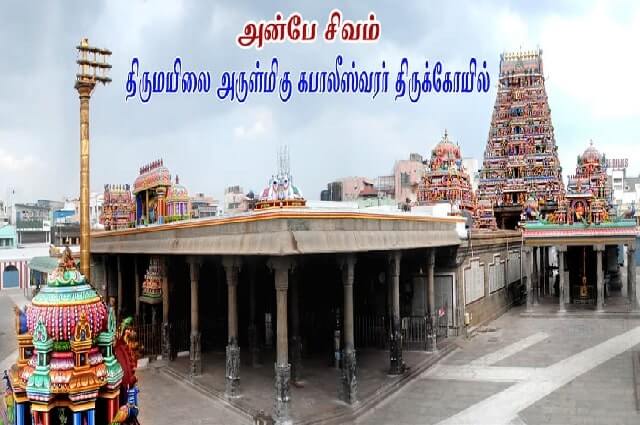
Contents
Kabaalishwaran Temple: Mayilai Sri Kapaleeswarar Temple, one of the South India’s most important Saivite worship places in Mylapore, a prime location in the capital city of Tamil Nadu. It attracts many thousands of tourists including foreigners every year. In this temple, the name of the Lord is Sri KAPALEESWARAR. The name of the Goddess is Sri KARPAGAMBAL. It is a lovely temple with a Stately Spire on its eastern side and a big tank on its West. The temple and the tank are surrounded by Broad streets on the four sides. The view of the temple and the tank is pictures. Mylapore is on the sea coast and the shore is away by half a mile of thickly populated residential area.
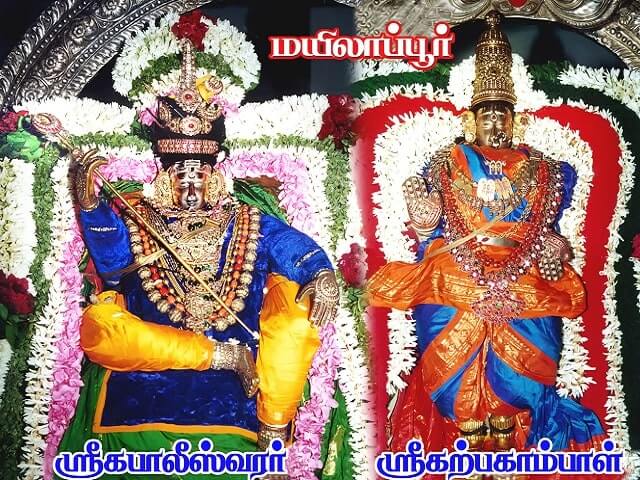
Goddess Uma in the guise of Peacock worshiped Lord Shiva. Lord Muruga got his Sakthivel from Lord Shiva and Mother Uma. Lord Brahma got back his job of creation after shedding his pride. Vedas worshiped Lord Kapaleeswarar and hence Mylai is known as Vedapuri. Sukaran prayed to Lord Shiva here. Hence Mylai is also called Sukarapuri. Lord Sri Rama stayed here and performed pujas to Lord Shiva with festivals.
In this holy soil, Thirugnana Sambandar restored Poompavai from her ashes and preserved bones. Birthplace of saint Vaylar, one of the 63 saints. Birthplace of Peiazhwar, one of the Twelve Azhwars, Saint Arunagirinathar sang the glory of Lord Singaravelan in Thirupugazh. Birthplace of great saint and poet Thiruvalluvar whose Thirukural is a classic Tamil Sangam literature consisting of 1330 couplets. On this holy soil, Saint Sambandhar sang the first piece of literature Muttatta Punnayam.
The name Mylapore is derived from the legend that the Goddess Uma worshipped Siva in the form of a peacock (or Mayil in Tamil). We can see a representation of this legend on stone in a small Shrine under a Punnai tree (Sthala Vriksha) in the Courtyard of the temple. Once, Goddess Uma desired to know the complete interpretation of the five-letter mantra Na Ma Shi Va and the splender of the sacred ash (Vibuthi).
Goddess Uma persuaded Shiva to touch teach her. Shiva consented and commenced teaching. However, Goddess Uma was distracted by a beautiful peacock and her attention wandered. Siva was infuriated and cursed her to go to sacred Thondai Nadu and perform penance. Goddess Uma worshipped the Shivalinga under the Punnai Tree in the temple vicinity. Moved by Goddess Uma utmost devotion, Lord appeared before Her and released Her from the curse, and fondly called her as Karpagavalli.
Goddess Uma requested Lord Shiva to name the place Mylapore and stay back with her to bestow blessings on all the devotees. Accordingly, Mylai became the abode of Kapaleeswarar and Karpagambal. There is another legend associated with Mylai being called Kapalesswaram.
Lord Brahma thought that he was as great and equal to Lord Shiva as he too had five heads. Shiva known for his spontaneous reaction decided to teach Brahma a lesson and cut down his ego. Shiva nipped one head and held the skull in his hand. Therefore Lord Shiva was praised as Kapaleeswarar and the place of worship is called Kapaleeswaram.
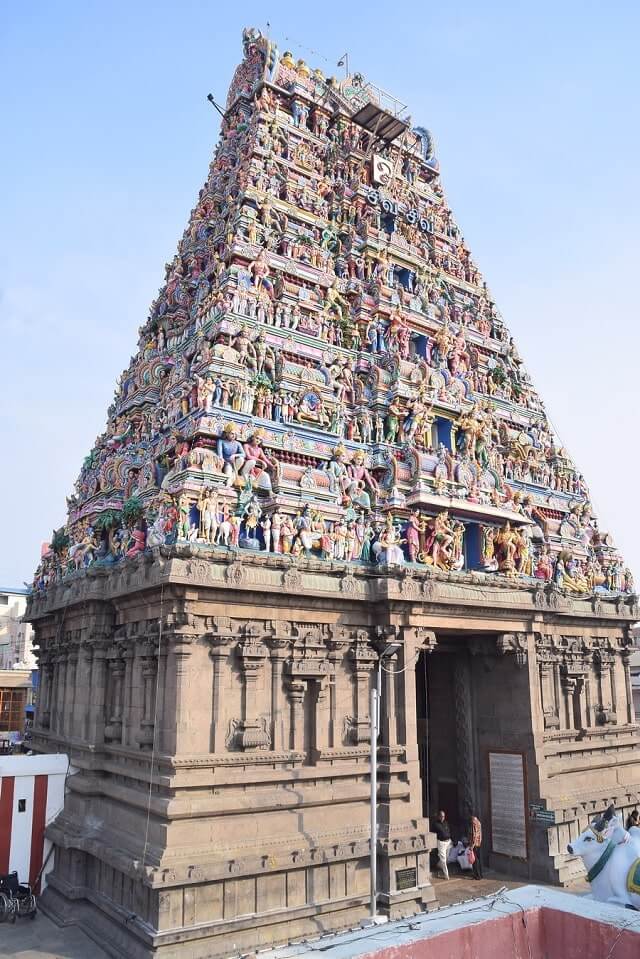
Rajagopuram is 117 feet tall, and has 3800 dolls depicting different themes. The temple is a testimonial for the Vishwakarma sthapathis. There are seven inlays in this gopuram on all four sides. On the east side the Siva Murthangals are depicted as dolls. On the south side, Dakshinamurthy (Siva murthangal) in eight different forms can be seen. Siva and Hari Leelaigal are also depicted. On the west side, the adventure of Hari (Vishnu) and a few Nayanmars are seen. On the north side, eight thiru kolangals are depicted. Anjaneya swami, Dikshithars, and Siva devotees are well arranged.
First layer of the dolls reflect human lives like Rama, Chandikesvarar, Siva kudumbam, and Neelakanta Dikshithar. On the second layer, Gnanasambandar is shown. The third layer shows Sundara Murthy Nayanar and Gajari, Urthathandavam. The fourth layer is Bhairavas and Dikpalars. The fifth layer ashta Murthangal like Narasimhar, Sarabar, and Krishna Leela is seen. On the fifth layer is also Siva Saiyuja Murthangal. On the sixth, are Siva Hamsa, Rudran, Easwaran, Maheshwaran, Brahma, and Vishnu. On the seventh, only Siva Hamsam- Sadasiva Murtham and Karnam (space for lamp).
In ancient times, the light on top of the gopuram served like lighthouses of today as most of the temples are located near the sea shore. There are nine Kalasangals on top of the gopuram which depicts the nine different holes (nava dhwaram) in a human body. Gopuram is known as Sushma Lingam meaning the God inside temple is shown. The reason is that if one is unable to go to the temple, they can look at the Gopuram and get the same palan (benefit).
The tip of the kalasam is sushma lingam. The temple is divided into three parts viz Brahma Bagam, Vishnu Bagam, and top is Siva Bagam. The temple strictly adheres to Ayathi Sastharam of Silpa Shasthra. The sastra stipulates that the Rajagopuram should be 12 times that of the main deity.
The rock foundation of the main gopuram reflects the contribution of Pallavas and Vijayanagar Kingdom. The dolls of the gopuram came into existence in the 19th century. Before that, it was only long rock pillars. The varagu rice inside the kalasams serves as a lightning arrestor. The kalasam rests on red wood which takes the shock of lightning.
The temple is enclosed by a compound wall (mathil) with the main entrance with a gopuram in the east. There are two entrances to the temple marked by the gopuram on either side (East and West). The smaller gopuram faces the sacred tank.
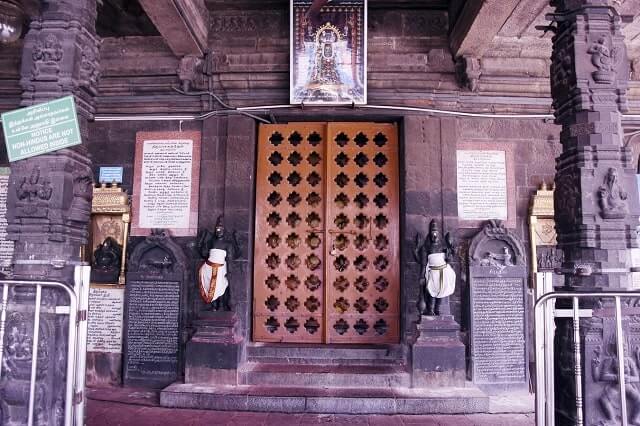
Subshrines Details – The main deity Arulmigu Kapaleeswarar is facing West in the form of Shiva Linga. Punnai Vanathu Eesan, Veda Nagarinan, Sukhra puriyan, Kapaleeswaraththinan, are the names to identify this deity. This main idol has been Utshava idol is also inside the Sanctum Sanctorium. Shiva facing the west is known as Sathyo Jatham.
Thirugnanasambandhar has praised Kapaleeswarar in his Thevaram. Goddess Parvathi was given salvation in this temple by Lord Kapaleeswarar. This deity has been worshiped by Brahma and Rama. There are several verses in praise of Lord Kapaleeswarar. Special Abishegam in Pradosham, Sivarathiri, Full moon day, Amavasai and Tamil new year.
The sacred shrine of Kapaleeswarar is situated in an area that is 8 meters in length and 6.5 meter wide. The sanctum sanctorium contains the Lingam. At the entrance are the Dwarapalakas or gate keepers who keep vigil. Traditional oil lamps like the decorative Surya and Chandraprabhai adorn the idol giving a glow and positive energy. The Lingam here is a symbol of the form and formless aspects of the divine. The Lingam is adorned with flowers and bhilva leaves, rudraksha garland and vibhuthi (sacred ash). On special occasions, the peeta (base) will be covered with silver plate and over the Lingam will be the silver hooded snake.
Kapalaeeswarar sannidhi has many idols of consecrated deities and saivite saints surrounding it. On the South wall, the deftly sculptured Selva Vinayakar is there, ready to give boons. On the right side , a 6 sq. meter shrine for Arumugaswami is located. On the north, a 9 sq. meter shrine for dancing Nataraja exists. Opposite to the Nataraja shrine, Durgai Amman idol is installed.
The 63 Nayanmars are located, as also Bitchadanar, Chandrasekar. On the west side Singaravelar utsava vigraham is instllaed. Only here the spouse of Gnanasambandar, Sosthirapurani is installed. Virabadarar, Bairavar, Durga, Lakshmi, Saraswathi are also seen here. 63 nayanmars in sculpture is seen here. Purachnada guru Meikanda devar, arul nandi sivam, maraignana sambandaar, umapathy sivam, Kapaleeswarar sametha karpagambal as utsava moorthy,( Somaskandar) are all kept here.
A memorial shrine in his name was built in an area of 15.5 sq meters. His shrine is on the west side of Palani Andavar. The saint gets special attention on his star (Revathi) birthday. In the month of Markzhi (December), Vayilar is given a special puja and taken around in a highly decorated flower palanquin around the streets (Mada streets) of the temple.
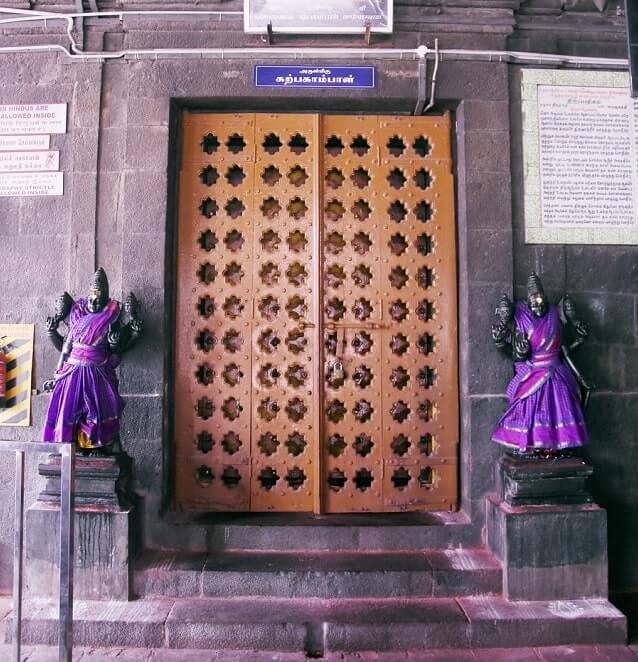
Subshrines Details – Karpagambal sannidhi is situated to the north of Kapaleeswarar shrine. The Amman sannidhi occupies 65 sq. meter area. The deity faces the South direction. In front of the goddess, facing her is a stone sculpture of a Lion, the mount of the Goddess. The walls in this Sanndhi are inscribed with Abhirami Andathi, Lalitha Sahasra Naamam, Lalitha Trisadhi.
Navarathri festival is held for Karpagambal. Six pujas are performed every day. In the month of Puratasi (October), the Navarathri celebration is conducted in a magnificent manner. During Adi Puram, Vaikasi pournami occasion the Santhana kappu is performed . The sandalwood paste is applied on the deity. On the auspicious Adi Friday , and Thai Friday , the Amman is given special abhishkam. During the month of Thai , yegadina latcharchani is done.
Every Friday, Karapagambal is adorned with a 1008 sahasaranama garland. Every Tuesday, Ambal gets archana with 108 silver lotus. On Wednesdays, Karpagambal wears a silver skirt. Ambal is taken around the temple in the golden chariot.
Tank Details – The holy water in the tank is known as KAPALI THEERTHAM This biggest holy tank is situated between Ramakrishna Road and this temple covered four sides and having Neerazhi Mandapam is in the center of the holy tank. Three days float festivals conducted once in every year. The tank is 629 feet in length and 475 feet in breadth. The tank has a 40 sq meter mandapam on the Westside and accommodates the Iyoshta Devi also known as Moodevi.
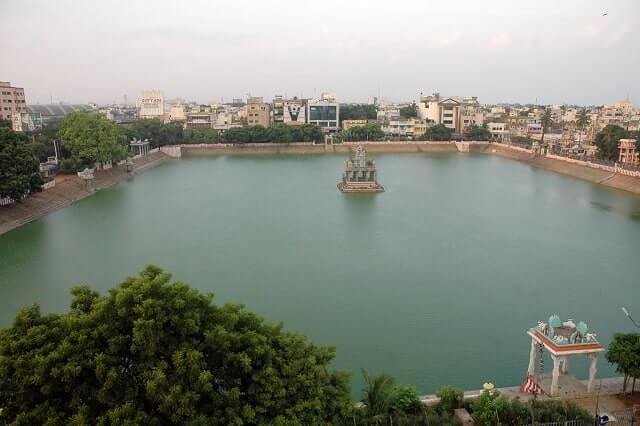
Arulmigu Kapaleeswarar Temple is open from Morning 05:00 AM to 12:30 PM and from Evening 04:00 PM to 09:45 PM. Only on Mahashivarathiri, Temple will be open for 24 hours.
| Pooja Name | Pooja Timings |
|---|---|
| Ko Pooja (Flower and Kunkumam and Santhanam) | 05:30 AM to 06:00 AM IST |
| Vaikarai Pooja (Abhishegam and Alangaram) | 06:00 AM to 07:00 AM IST |
| Kalasandhi pooja (Abhishegam and Alangaram) | 08:00 AM to 10:00 PM IST |
| Uchikkala Pooja (Abhishegam and Alangaram) | 11:00 AM to 12:30 PM IST |
| Sayaraksha Pooja (Evening) (Abishegam and Alangaram) | 04:00 PM to 06:30 PM IST |
| Ushakala poojai | 06:30 PM to 07:30 PM IST |
| Ardhajama Pooja (Abhishegam and Alangaram) | 09:00 PM to 09:45 PM IST |
Kapaleeswarar Temple Contact Number: +914424641670
Kapaleesvarar, Sannadhi St, Mylapore, Chennai, Tamil Nadu 600004